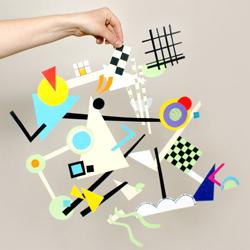
Introduce children Wassily Kandinsky's original artwork. Get them used to abstract art, its graphic appearance and the music that inspired the artist to create his rhythmic, colourful pieces.
Using this sheet, you can encourage children to experiment with abstract art, each activity is aimed at bringing the music to life on paper. The activities will develop children's attention span, sensitivity and creativity. During one or several sessions they can take on the role of a composer, by cutting and drawing.
Wassily said, "White sounds like silence, the nothing before it all begins," so get your paper ready!
Historical period: 20th century - Abstract Expressionism.
Vassily Kandinsky, was born in Moscow on 4th December 1866 and died at Neuilly-sur-Seine on 13th December 1944. He was a Russian painter, printmaker, art theorist, poet and playwright who was granted German, then Ukranian, then French nationality in 1939. Considered one of the most important artists of the 20th century alongside, most notably Picasso and Matisse, he is one of the founders of abstract art. His wife, Nina Kandinsky left all the Kandinsky works in her possession to the Georges-Pompidou centre in Paris.


